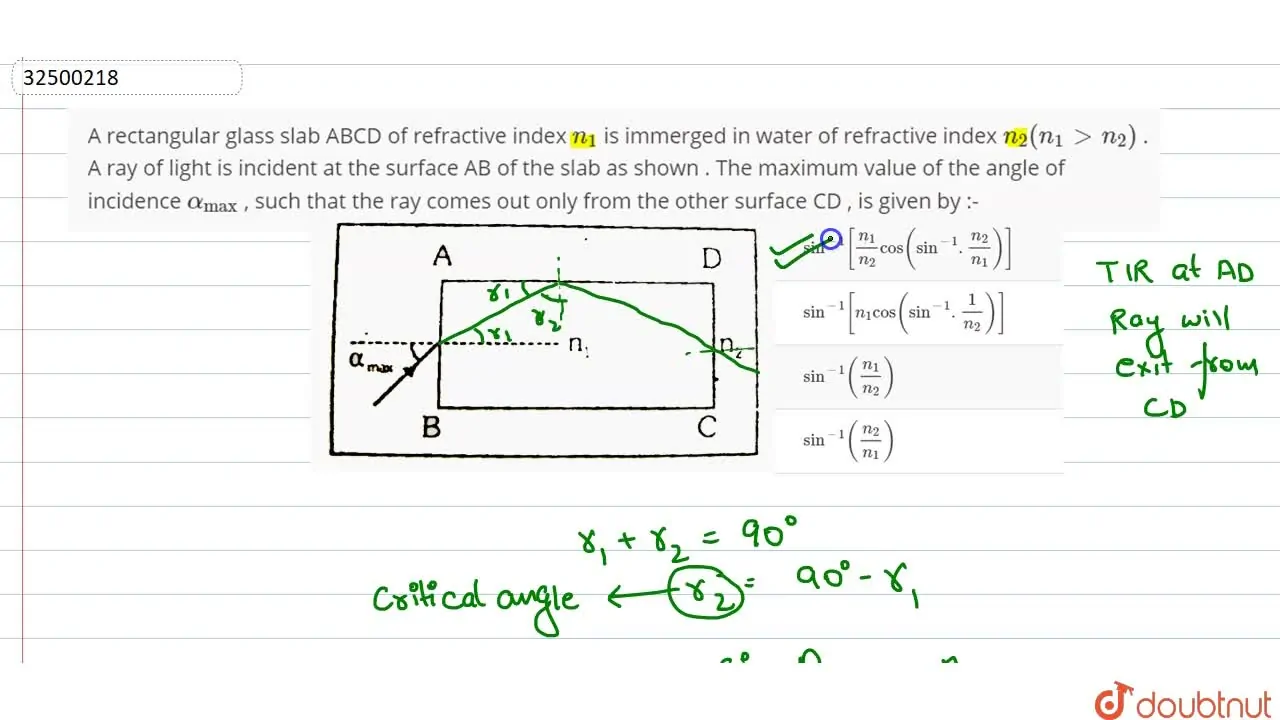A rectangular glass slab ABCD of refractive index n1 is immerged in water of refractive index n2(n1>n2) . A ray of light is incident at the surface AB of the slab as shown . The maximum value of the angle of incidence αmax , such that the ray comes out only from the other surface CD , is given by :-
_E01_205_Q01.png)
sin−1[n1n2cos(sin−1.n2n1)]
sin−1[n1cos(sin−1.1n2)]
sin−1(n1n2)
sin−1(n2n1)
The correct Answer is:A
Rays come out only form CD , means rays after refraction from AB get total internally reflected at AD .
_E01_205_S01.png)
From the figure :
r1+r2=90∘
r1=90∘−r2
(r1)max=θC
[for total internal reflection at AD]
where sinθC=n2n1orθC=sin−1(n2n1)
∴(r1)max=90∘−θC
Now applying Snell's law at face AB:
n1n2=sinαmaxsin(r1)max=sinαmaxsin(90∘−θC)=sinαmaxcosθC
or sinαmax=n1n2cosθC
∴αmax=sin−1[n1n2cosθC]=sin−1[n1n2cossin−1(n2n1)]
Related Playlists
- BOOK - ALLENCHAPTER - GEOMETRICAL OPTICSEXERCISE - MCQ5videos
GEOMETRICAL OPTICS
- BOOK - ALLENCHAPTER - GEOMETRICAL OPTICSEXERCISE - MATCHING2videos
GEOMETRICAL OPTICS
- BOOK - ALLENCHAPTER - GEOMETRICAL OPTICSEXERCISE - EXERCISE-05 (A)35videos
GEOMETRICAL OPTICS
- BOOK - ALLENCHAPTER - CURRENT ELECTRICITYEXERCISE - All Questions427videos
CURRENT ELECTRICITY
- BOOK - ALLENCHAPTER - GRAVITATIONEXERCISE - EXERCISE 49videos
GRAVITATION
Similar Questions
A rectangular glass slab ABCD, of refractive index n1, is immersed in water of refractive index n2(n1>n2). A ray of light in incident at the surface AB of the slab as shown. The maximum value of the angle of incidence αmax, such that the ray comes out only from the other surface CD is given by
View SolutionA rectangular glass slab ABCD of refractive index n1 is immersed in water of refractive index n2(n1<n2). A ray of light is incident at the surface AB of the slab as shwon. The maximum value of the angle of incidence αmax such that the ray comes out from the other surface CD is given by
 View Solution
View SolutionSelect the alternatatives.
(a) A diverging beam of light form a point source S having divergence angle α ,falls symmetrically on a glass slab as shown .the angles of incidence of the two extreme rays are equal .Fi the thickness of the glass slab is tand the refractive index nthe n the divergence angle of the emergent beam is (A) zero,(B) α(C)sin−1(1/n)(D)2sin−1(1/n)
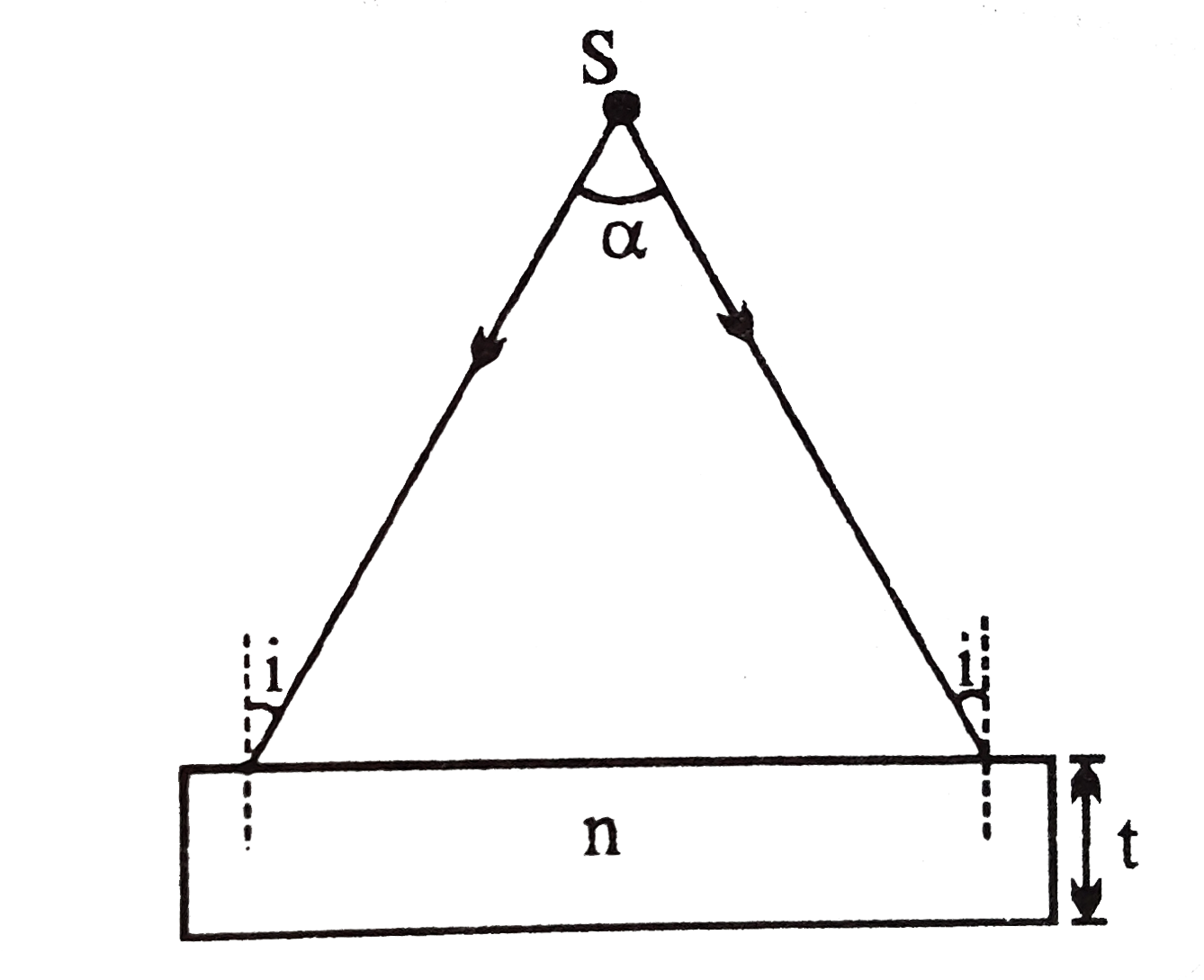
(b) Arectangular glass slab ABCDof refractive index n1 is immersed in water of refractive indexn2(n1>n2) A ray of light is incident at the surface ABof the slab as shown .The maximum value of the angle of incidenc eαmaxsuch that the ray comes out only from the other surface CDis given by
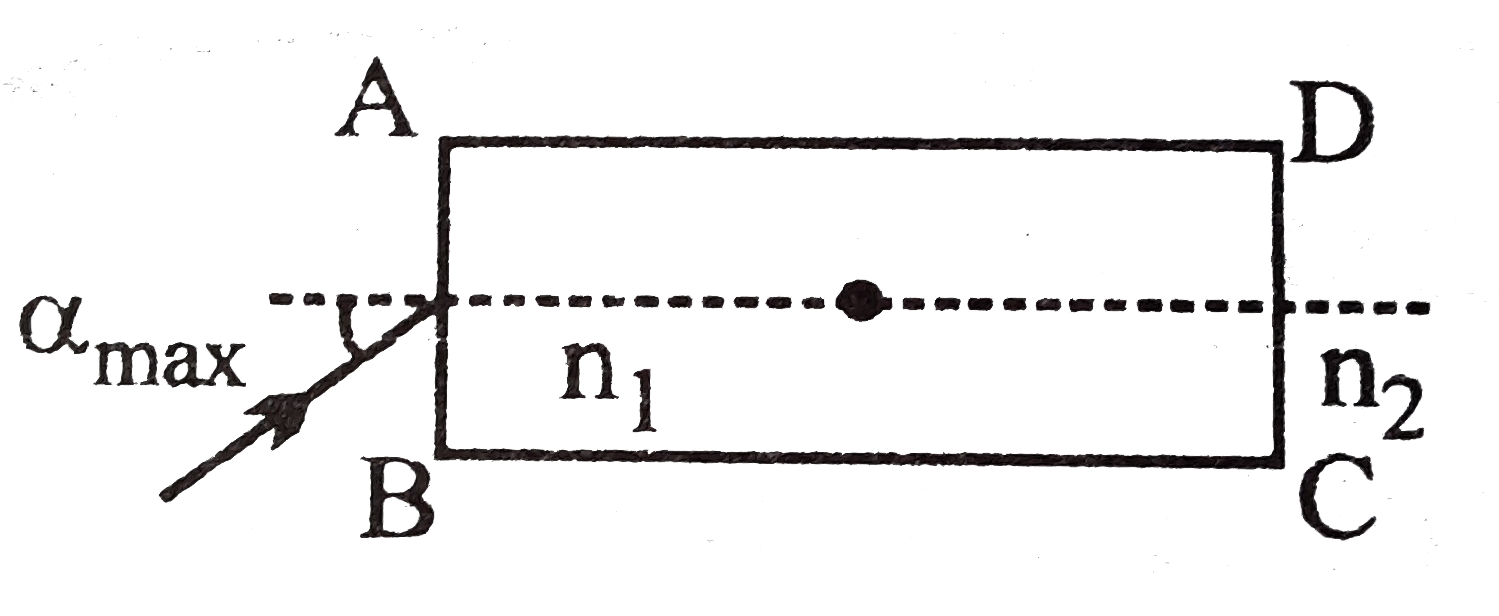 (A) sin−1[n1n2cos(sin−1n2n1)] (B)sin−1[n1n2cos(sin−11n2)](C)sin−1(n1n2)(D)sin−1(n2n1)
(A) sin−1[n1n2cos(sin−1n2n1)] (B)sin−1[n1n2cos(sin−11n2)](C)sin−1(n1n2)(D)sin−1(n2n1)
(c) A point source of lightB is placed at a distance L inother of the centre of a mirror of width hung vertically ona wall A man walks is front of the mirror along a line parallel to the mirror at a distance 2L from it as shown .the greatest distance over which he can see the image of the light source in the mirror is (A)d/2 (B) d,(c )2d,(d)3d, a hollow double concave lens is made of very thin transparents meterial .It can be filled with air or either of two liquids L1andL2having refractive indicesn1andn2respectively(n2>n!>1) the lens will diverge a parallel beam of light of it is filled with (A)air and placed in air.(B) air and immersed inL1(C ),L1 and immersed inL2 (D),L2 ans immersed in L1View Solution
a hollow double concave lens is made of very thin transparents meterial .It can be filled with air or either of two liquids L1andL2having refractive indicesn1andn2respectively(n2>n!>1) the lens will diverge a parallel beam of light of it is filled with (A)air and placed in air.(B) air and immersed inL1(C ),L1 and immersed inL2 (D),L2 ans immersed in L1View SolutionA rectengular glass slab ABCD of refractive index n_1 is immersed in water of refractive index n2(n1>n2). A ray of light is incident at the surface AB of the slab as shown. The maximum value of the angle of incidence αmax such that the ray comes out only from the other surface CD is given by
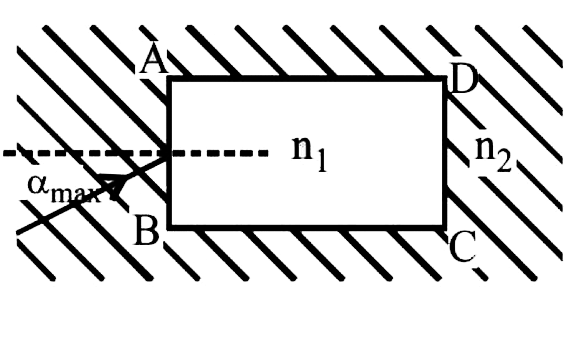 View Solution
View SolutionA rectangular slab ABCD, of refractive index n1 , is immersed in water of refractive index n2(n1<n2). A ray of light is incident at the surface AB of the slab as shown in Fig. Find the maximum value of angle of incidence αmax, such that the ray comes out only from the other surface CD.
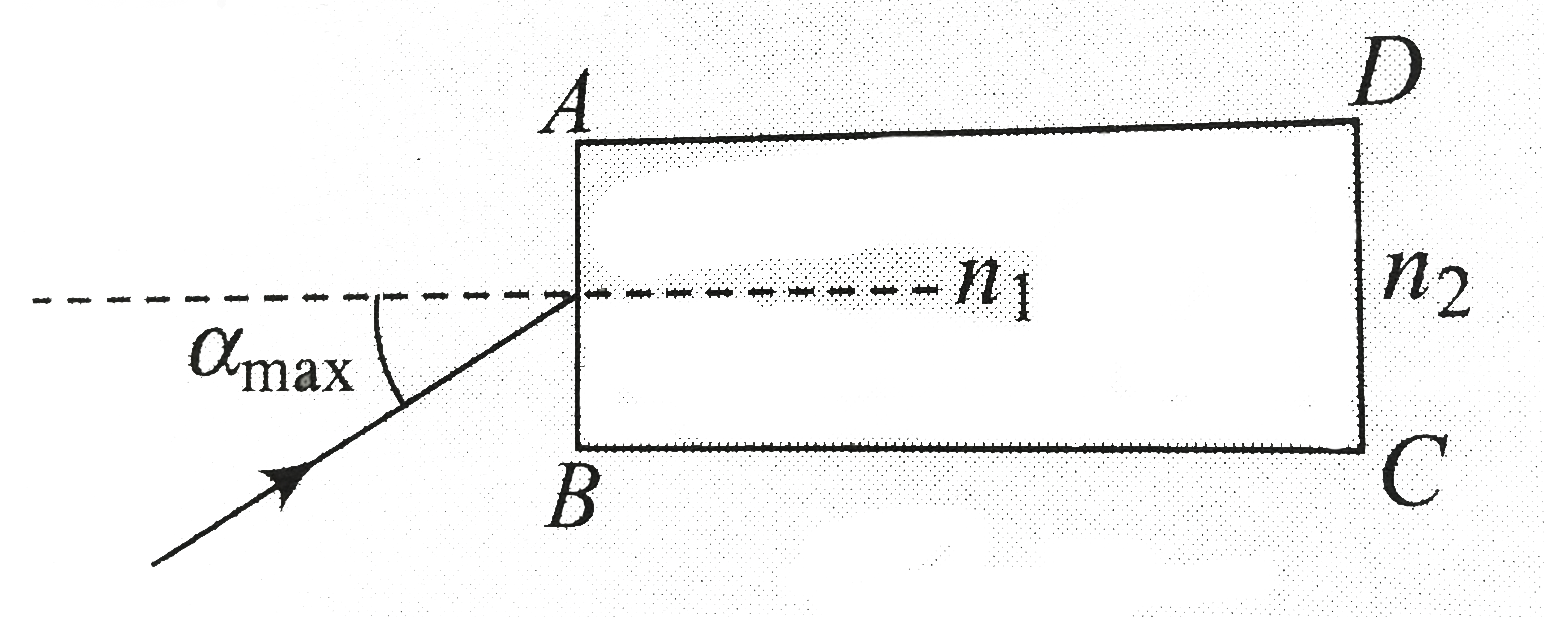 View Solution
View SolutionA glass slab made of a material of refractive index n1 is kept in a medium of refractive index n2.
A light ray is incident on the slab. Draw the path of the rays of light emerging from the glass slab, if n1>n2View SolutionA glass slab made of a material of refractive index n1 is kept in a medium of refractive index n2.
A light ray is incident on the slab. Draw the path of the rays of light emerging from the glass slab, if n1=n2View SolutionA glass slab made of a material of refractive index n1 is kept in a medium of refractive index n2.
A light ray is incident on the slab. Draw the path of the rays of light emerging from the glass slab, if n1<n2View SolutionA ray of light is incident on a parallel slab of thickness t and refractive index n. If the angle of incidence θ is small, than the lateral displacement in the incident and emergent ray will be
View SolutionA ray of light is incident on a parallel-sided glass slab as shown in the figure. The angle of refraction for this ray of light is likely to be :
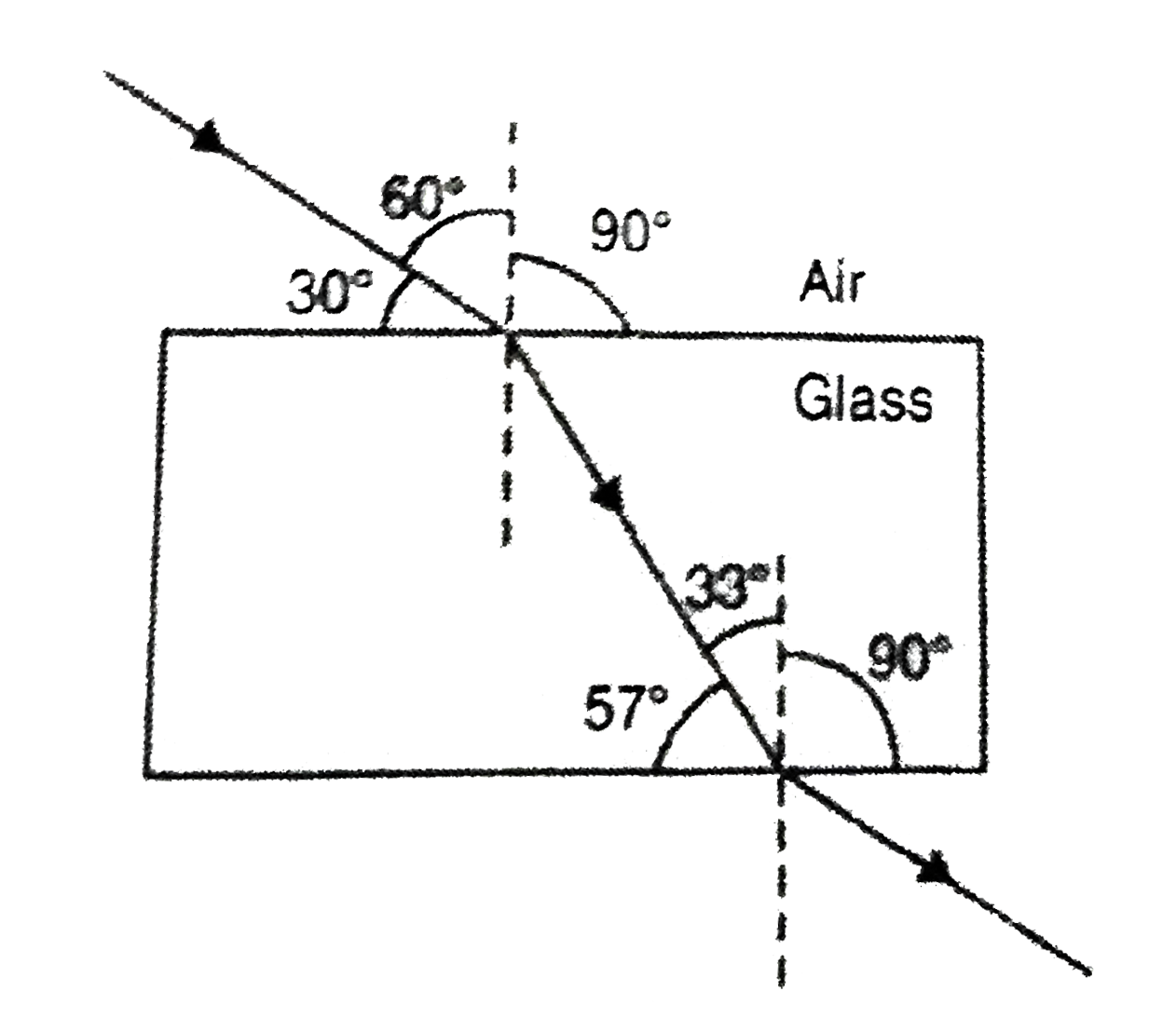 View Solution
View Solution

